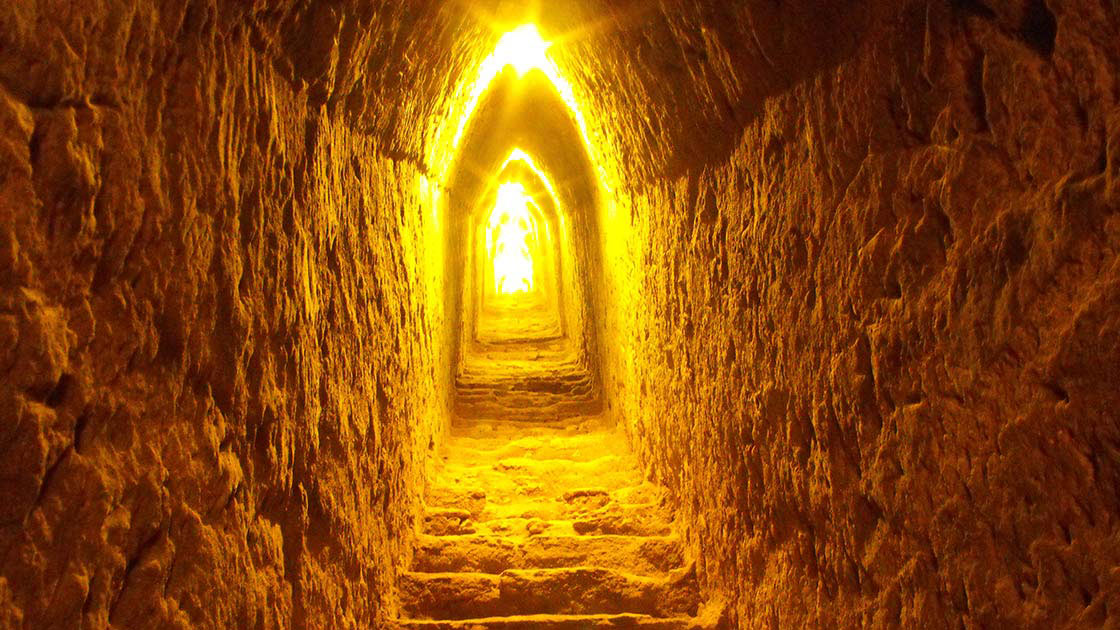The 2022 Netflix series entitled Ancient Apocalypse is a tour de force in presenting the core ideas of Graham Hancock. The photography, the detailed art of reconstructed ancient monuments and sites, and the integration of concepts and ideas are truly sublime. And Hancock not only presents himself as a wise and knowledgeable person, but as also an excellent and eloquent documentarian and writer. After my review of his book Magicians of the Gods in Skeptic1 and the debate Michael Shermer and I had with Hancock on the Joe Rogan Experience, I have come to respect his sincerity and gentle demeanor through our subsequent correspondence. I think of him as a friend, and I hope he feels the same way toward me.
Unfortunately, as a practicing scientist and spokesperson for applying critical thinking not only to purely scientific, but historical and literary research as well, I feel obligated to identify what I see as his erroneous conclusions in both this series and in his many books, which have been highly influential in presenting an alternative theory of history to those less prepared to evaluate the evidence (or lack thereof). In brief, according to Hancock’s alternative theory of history, indigenous peoples were incapable of building the early sophisticated archaeological structures and monuments across the globe, and so he asserts that these hunter- gatherers have “a shared legacy from a lost global civilization that provided the seeds and the spark of inspiration from which many later civilizations grew.” Who are these “magicians of the gods,” as Hancock describes them, and where did they come from?
In a word, Atlantis. Hancock effervesces over this lost society, telling us they were “a precocious civilization boasting beautiful architecture, advanced technology, and city planning on a monumental scale. It also commanded a vast fleet capable of navigating the world, projecting its power near and far across oceans until the city was struck by a series of massive earthquakes and floods — a truly cataclysmic event — and sank beneath the waves.” Before they perished, however, Hancock conjectures that some survived the cataclysm and shared their knowledge with peoples around the world, giving rise to the great civilizations of history.
There is one major problem with Hancock’s story — there is no patent evidence for this lost civilization. Instead, he invokes myths, fanciful and often incorrect interpretations of archaeological sites, anomalies from said sites that archaeologists allegedly cannot explain, and Plato’s story about Atlantis, which Hancock reads as nonfiction instead of myth. Finally, at the end of the series, we learn that Graham’s lost advanced civilization was destroyed by a series of comet strikes, thereby wiping from the historical record (save those archaeological anomalies) any trace of it.
In a final communication from the ancients to us moderns, Hancock also believes that there are hidden messages at an archaeological site in Turkey called Göbekli Tepe, warning us that another series of comet strikes is on the way to destroy us if we don’t change our ways. Let’s examine his claims in detail.
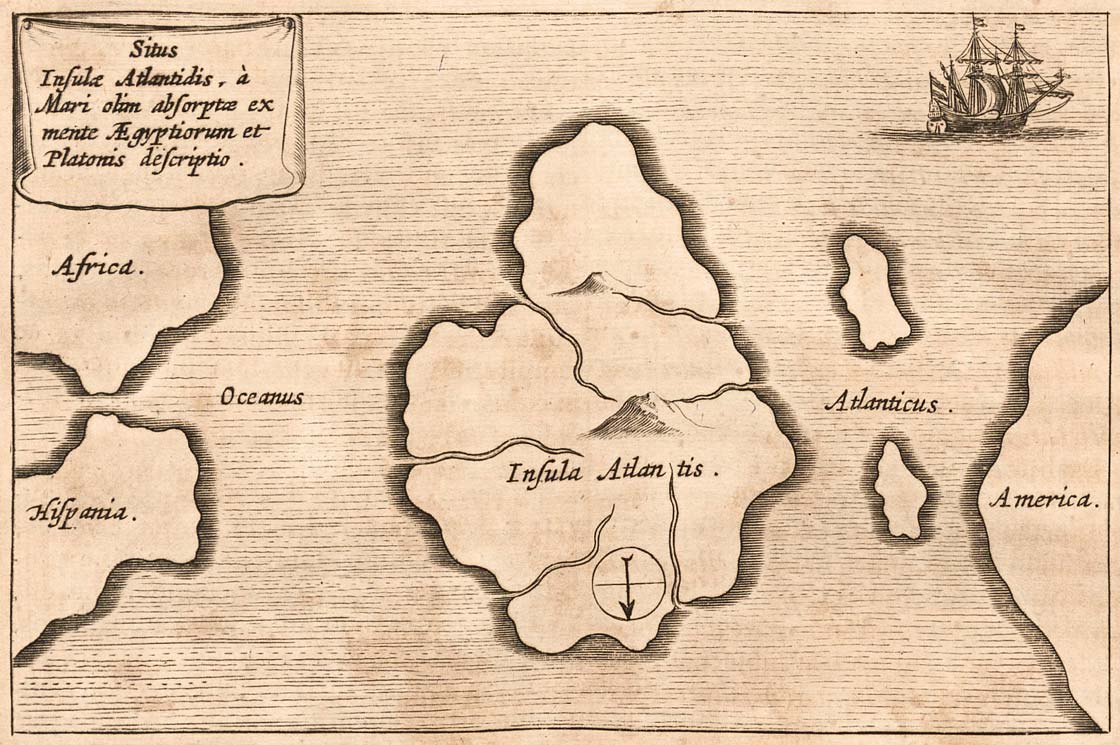
Figure 1. Athanasius Kircher’s 1664 map of Atlantis with north at the bottom of the map. The map is based on Plato’s dialogues.
Atlantis
Since Plato’s Atlantis looms large in Hancock’s story, let me briefly delve into the fictional origins of the lost continent. In Plato’s Timaeus, the ancient Greek philosopher has his dialogist Critias explain that Egyptian priests told the Greek wise man Solon, who was visiting Neith’s temple in Egypt, that his ancestors once defeated a mighty empire located just beyond the “Pillars of Hercules” (what we refer to today as the Straits of Gibraltar; see Figure 1). The relevant passage reads: “This vast power gathered into one, endeavored to subdue at a blow our country and yours and the whole of the region within the straits; and then, Solon, your country shone forth, in the excellence of her virtue and strength, among all mankind.” Afterwards, however, “there were violent earthquakes and floods; and in a single day and night of misfortune all your warlike men in a body sank into the earth, and the island of Atlantis in like manner disappeared in the depths of the sea.”
The public appears to see Graham as fighting an intransigent scientific community out to destroy him. Not so! If he wants the respect of the scientific community, he should submit his work to peer review and stop crying “persecuted genius.”
Kenneth Feder, an archaeologist at Central Connecticut University, states: “in his [Plato] tale, ancient Athens, even in detail, matches precisely the hypothetical perfect society of Socrates.”2 Plato, a student of Socrates, has the temple priest tell Solon that ancient Athens defeated the great power from the Atlantic Ocean near the Pillars of Heracles — the island nation of Atlantis. We know Atlantis was a literary device employed by Plato because there is never any mention of the battle by Greek historians of the day. Nor is there any mention of Atlantis in Egyptian history where supposedly Solon learned of it. Feder continues: “It is inconceivable that there would be no mention of a great military victory by ancient Athens over Atlantis — or any place even vaguely like it — in the works of Greek historians who followed Plato.” It is clear from such glaring omissions that the Atlantis story was contrived by Plato to serve as a warning, juxtaposing a morally corrupt society (Atlantis) with a perfect society of Athens.
Persecuted or Ignored?
In the Netflix series, Hancock continually complains about the condescending attitude displayed toward him by the scientific community. He tells us he is “enemy number one” among archaeologists, adding: “Perhaps there has been a forgotten episode in human history. But perhaps the extreme defensive, arrogant, and patronizing attitude of mainstream academia is stopping us from considering that possibility. I am trying to overthrow the paradigm of history.”
I believe what he really objects to is not so much a perceived hostility toward him but the way the scientific community ignores his work. Google Scholar keeps track of the number of times research papers and books are cited in journals and by whom. The number and quality of the citations are important metrics for promotions and tenure within the academy. When I search for citations of Hancock’s work, however, I find nothing from scientific journals. One of the major reasons no one in the scientific community takes him seriously is because he circumvents the peer-review process and publishes his ideas in popular books and articles only (and now on Netflix).
It’s not just outsiders such as Hancock who get the cold shoulder from the scientific community. Consider what happened in 1989 when Martin Fleischmann and Stanly Pons announced that they had discovered fusion at room temperature — cold fusion — to the press before their papers were peer-reviewed. As Gary Taubes documents in his aptly titled book Bad Science: The Short Life and Weird Times of Cold Fusion, they not only turned out to be wrong, but their careers were effectively destroyed. This happened not because they were wrong but because they announced what, if true, would be one of the greatest discoveries in science history before other scientists had a chance to scrutinize their evidence and test their claims. The scientific method requires peer review to assure cutting-edge research is substantially documented by empirical evidence before publication.
If Graham Hancock truly wanted to “overthrow the paradigm of history” he would submit his work to the scientific community in peer-reviewed journals and at professional meetings, in addition to presenting them directly to the public. I have published many scientific research papers during my career, and I know firsthand that it is a difficult and often frustrating process. You need a thick skin because the review process can sometimes include harsh criticism. Many papers are rejected for many reasons. Most papers that are eventually accepted go through multiple rewrites based on editorial and peer comments. Hancock’s characterization of the scientific community as “defensive, arrogant, and patronizing” is unfair and inaccurate. If you want to be taken seriously by scientists, this is the process you must go through. Unfortunately, the public appears to see Graham as fighting an intransigent scientific community out to destroy him. Not so! If he wants the respect of the scientific community, he should submit his work to peer review and stop crying “persecuted genius.”
The Bigotry of Low Expectations
A central theme in the Netflix series is that various archaeological sites around the world are too complex and monumental for earlier cultures to have built, most notably:
- Gunung Padang in Indonesia,
- the Great Pyramid of Giza,
- Cholula, Texcotzingo, and Xochicalco in Mexico,
- Ggantija, Mnajdra, and Ghar Dalam in Malta,
- Bimini Road in the Bahamas (which is natural and not manmade3),
- Göbekli Tepe, Karahan Tepe, and Derinkuyu in Turkey,
- Poverty Point in Louisiana,
- and Serpent Mound in Ohio.
At Derinkuyu, for example, Hancock notes that the visitor “notice boards” state that the tunnels were carved out by Christians in 650 AD while trying to hide from Arab raiding parties, then adds that the story “appeals to western tourists… but it is totally wrong.” From there he upbraids archaeologists and curators of archaeological sites:
We encounter this again and again on archaeological sites around the world. There is a notice based on the received wisdom of archaeologists. Again and again that notice is wrong. Factually wrong. Proved to be wrong by later excavations and yet not changed. Don’t trust the notice boards. Do the leg work yourself. Don’t rely on the so-called experts.
Two things stand out here. First, later work by archaeologists can often update the age of various sites. The notice boards at sites do not always get updated as quickly. The important point is that science is ever changing, challenging the main paradigms with further work. This is precisely how the scientific method should work. I have no doubt that the tunnels at Derinkuyu were used by Christians to hide from the Arabs. But why is Hancock so upset that later research suggests they may have been excavated earlier, in 750 BC? I suggest he has a not-so-subtle agenda, captured in his oft-quoted slogan (even emblazoned on a t-shirt) “stuff just keeps getting older.” Hancock believes that archaeologists are frequently mistaken about the ages of archaeological sites, all in the direction of dating them to be too young. In this case, his aim is to suggest that the people at Derinkuyu were trying to hide from another cataclysm, like the one 12,800 years ago that supposedly destroyed his advanced lost civilization. If archaeologists were wrong about the 650 AD date, it invites the reader to believe that they might be wrong about the 750 BC date too. He states: Derinkuyu was “built much longer ago than archaeologists are willing to consider…back as far as the last ice age.” However, nothing at Derinkuyu has ever been found to suggest it is anywhere near that old. This is pure conjecture, partly based on his reading of myths, and is typical of Hancock’s approach to many such archaeological sites.
Second, Graham urges: “Do the leg work yourself.” I have never once seen Graham Hancock doing any of the hard work archaeology demands. You will never find him on his knees with trowel and brush painstakingly excavating a site for months and years. He is an armchair pseudo-archaeologist, flying into a site for a couple of days as the cameras roll showing him wandering around making observations and speculations. Yet he feels qualified to challenge what he calls the “received wisdom” of professional archaeologists and geologists. In fact, the “received wisdom” is the result of long hours and hard work and an equal or longer time of careful comparative analysis done over many years in order to ascertain true scientific knowledge about these sites.
Testing the Hypothesis
Is there any way to test Graham Hancock’s hypothesis about the remnants of a lost advanced civilization having been the purveyors of advanced technology, architecture, and wisdom? It is a tough ask, considering he claims his lost advanced civilization left no traces when it was destroyed by a comet 12,800 years ago. So bear with me as we work our way through some human migrations in the context of this claim.

Figure 2. Estimations of the times at which Homo sapiens reached various areas of the world. Easter Island sits far off the coast of South America. The extent of ancestor populations such as Homo erectus and Neanderthals are also shown on the map (http://bit.ly/3GhOnjq).
Anthropologists, archaeologists, and geneticists have separately and together worked out a great deal about the peopling of the world. The first major wave of Homo sapiens out of Africa was about 70,000 years ago, probably driven by drying conditions (Figure 2). In general, the further humans roamed away from their starting point in Africa, the later their earliest arrival dates. As one might expect, the last places to be populated are the remote islands in the Pacific Ocean, in particular Easter Island/Rapa Nui (Figure 3). Polynesians did not reach relatively isolated Rapa Nui until around 1,000 to 1,200 AD. There may have been arrivals as early as 400 to 800 AD, but no archaeologist has even hinted at dates earlier than the first millennium. And for good reason — Polynesians had to row their wooden craft for more than 1,100 miles from the nearest Pacific island to reach the remote island, which lies yet more than 2,300 miles in the opposite direction from South America.
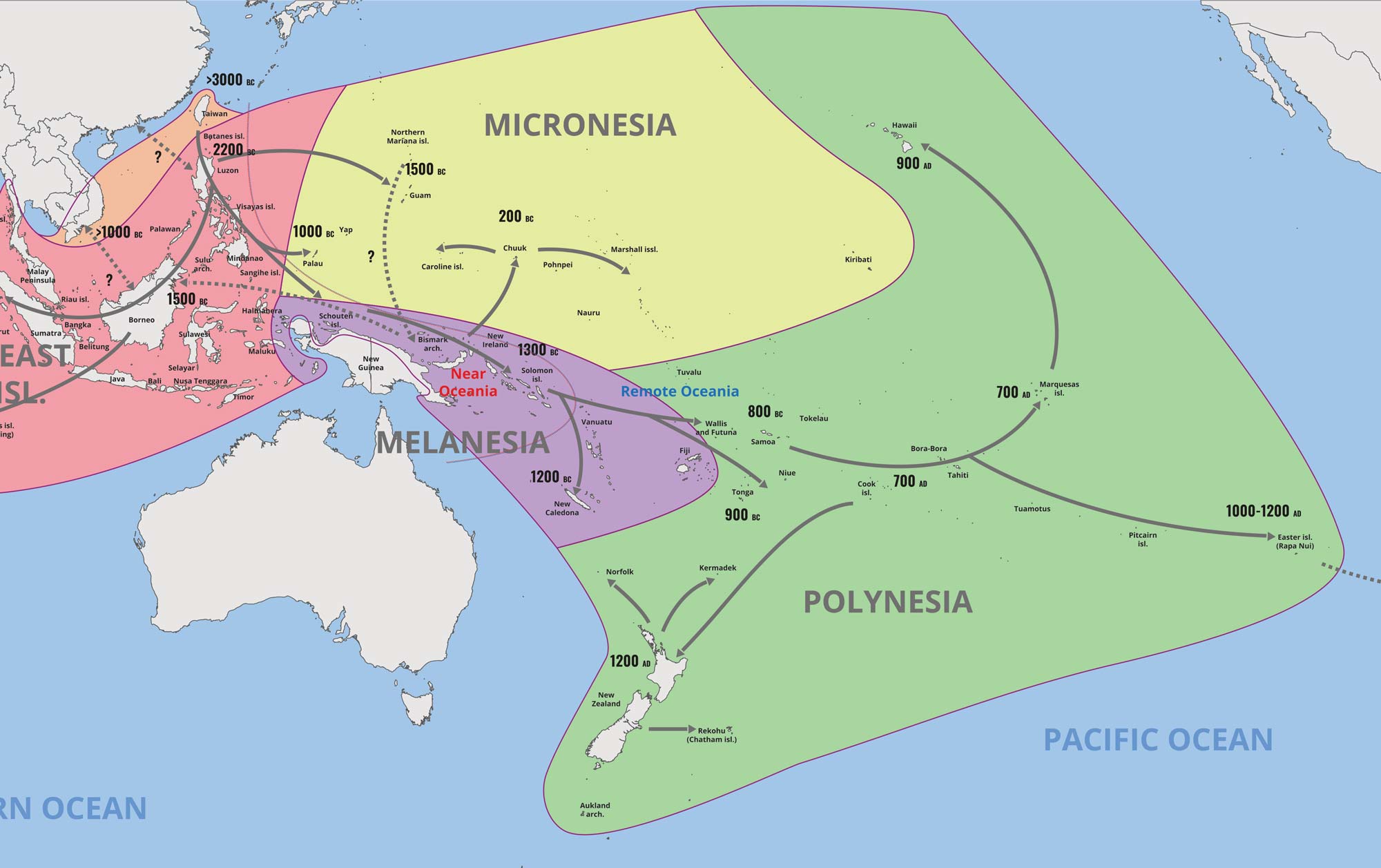
Figure 3. In the image, you can see when the Polynesians populated various islands in the Pacific Ocean (https://bit.ly/3GlqNlM). Most archaeologists believe Easter Island was the last island in the Pacific to be populated by humans.
When the first Polynesians landed on Rapa Nui’s shores they found a paradise of nearly 62 square miles of forested land, including over 20 species of trees. The rich volcanic soils also proved excellent for farming. UCLA archaeologist Jo Anne Van Tilburg, who worked on the archaeology of the island for more than 30 years, documents4 that the island may have supported as many as 20,000 inhabitants. However, as the population grew into the thousands and those trees were cut away to make room for farming, the soil eroded and the ecosystem began to collapse.5 By the time the first Europeans arrived on Rapa Nui on Easter of 1722, the land was almost completely denuded of vegetation and the human population had been reduced to a few thousand.
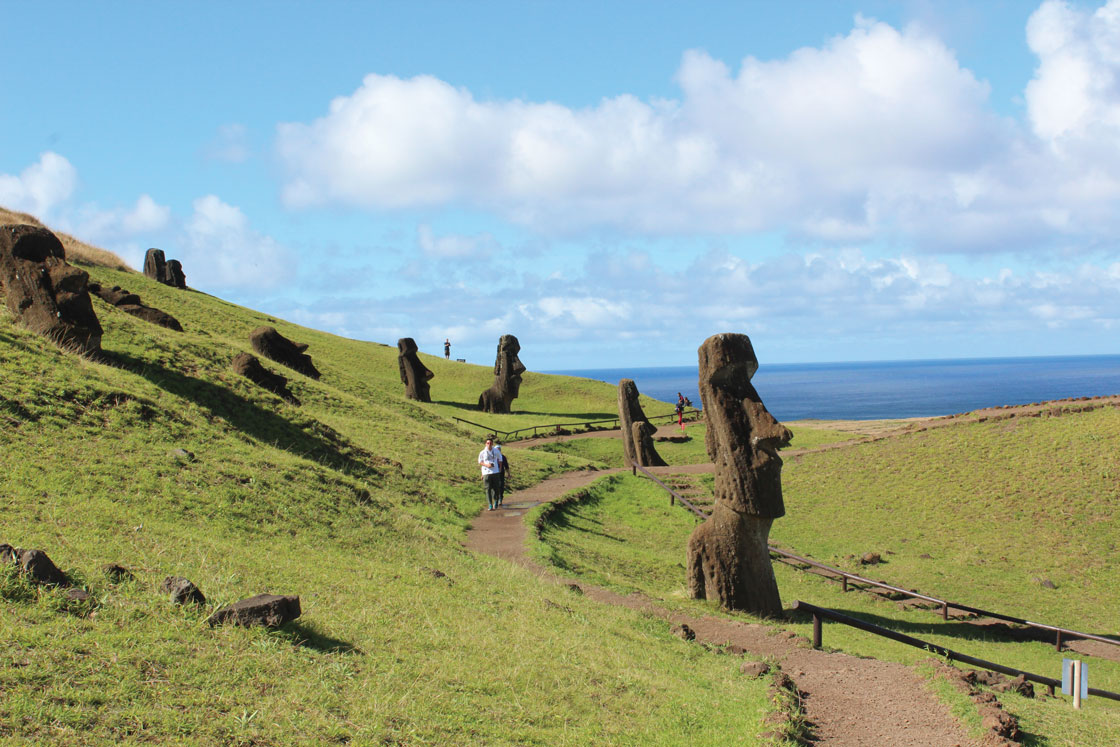
Figure 4. Moai on Easter Island (2018). Note the lack of palm trees and other vegetation. (Photo courtesy Marc Defant)
Most notable about Easter Island are the spectacular huge stone carvings termed moai (Figure 4). Based on radiocarbon dates, we know they were constructed between 1100 and 1650 AD. All the moai were carved at Rano Raraku crater where the source-rock tuff is exposed. It is estimated that a team of five or six men could carve a moai in about a year. The largest moai weigh about 75 tons and stand over 30 feet high, not including the rock foundations on which they stand. The moai were moved from Rano Raraku crater to sites usually along the coast. The latest research suggests they were moved by means of a rocking motion using ropes made from hau tree rough bark. A team of 15 people could manage the movement.6 There are over 887 of the monolithic moai and 125 of them were placed on stone foundations called ahu.
Based on the comprehensive work of Van Tilburg and her colleagues we know that the moai were made from stone tools by a stone-age culture. Excavations in the crater produced numerous stone tools from the quarry, including stone picks, hand stone chisels, and stone hammers. Rapa Nui is proof that mixed agriculture-hunting societies can produce spectacular and massive stone monoliths with the simplest of tools. We also know that these same people were able to move the huge and heavy moai over distances approaching ten miles (some partial statues now lay broken where they fell during transportation). In addition, there are over 4,000 petroglyphs that not only adorn some of the moai but are carved on rock throughout the island. And the moai occur no place else in the world. They are not the inspiration of some ancient, advanced civilization. They are the creation of an indigenous people with a proud culture. Before the ecocide, there was enough bountiful food on the island to support a large enough population with a large enough agricultural surplus to have enough time on their hands and enough food available to produce these exceptional works of art.
According to Hancock, however, the accepted earliest dating on the south Pacific islands is all wrong. His alternative history would require human settlements on Easter Island to have taken place more than 10,000 years earlier than any island in the South Pacific is accepted to have been populated. It would also require that the survivors of an advanced civilization made their way more than 10,000 years ago from Atlantis — purportedly located in the Atlantic Ocean outside the Straits of Gibraltar — to a tiny island in the middle of the south seas (a trip of over 10,000 miles), to teach the indigenous people living there how to build the moai. Are we to believe that the survivors of an advanced civilization influenced Polynesians more than 10,000 years before they arrived on Easter Island? That Polynesians were taught advanced statue-making techniques by the magicians of the gods and then 10,000 years later put those methods to use and only on Easter Island? If the Polynesians were taught supposedly advanced knowledge, why don’t we see the moai in other places in the Pacific? And why just on Easter Island, the last place on Earth to be inhabited by humans? In fact, there is no advanced knowledge at play here. While the statues are a remarkable achievement, there is nothing “advanced” about the way they were created.
Although I hope I have raised some serious questions about Hancock’s logic with the Easter Island example, the burden of proof is on Hancock to convince the scientific community of the validity of his alternative theory of history, and not on scientists to chase down every anomaly he has identified. By Karl Popper’s Falsification Principle, for a hypothesis to be scientific (rather than literary) it must be testable and falsifiable (that is, be able to be proven false). When Hancock declares that his lost advanced civilization was destroyed by a comet that left no trace of its existence, his claim is, by definition, non-testable and so non-scientific. It is pure supposition that a few survivors of the lost civilization (why they were not destroyed by the comet is never addressed by Graham) conveyed their advanced technology and wisdom to much simpler societies scattered around the world.
This is the same strategy that Erich von Däniken employed when he first proposed in the 1960s that ancient alien astronauts instructed ”primitive peoples” how to build their temples and monoliths. Von Däniken even argued that ancient aliens landed on Easter Island.7 In fact, in many ways, Hancock’s stories are parallel to those of von Däniken, only he switches from ancient alien astronauts to a lost advanced earthly civilization to resurrect the same tales.
What Is an “Advanced Civilization” Anyway?
A focal point of Hancock’s theory is the exceptional archaeological site of Göbekli Tepe in southeast Turkey along the border with Syria. The earliest sections of the site have been dated to 11,600 years ago.8 The site was excavated by the German archaeologist Klaus Schmidt, who spent his career studying it, along with his students who continued the work after his death.9 There they discovered that sections of Göbekli Tepe were backfilled to make room for later structures. The research involved an arduous amount of work over decades, carefully uncovering the site. Radiocarbon dating indicates the site was used between 10,000 and 11,600 years ago. Nothing has changed since I described the site10 in 2017:
The fill is refuse containing sediment, hundreds of thousands of broken animal bones, flint tools for carving the structures within the site and for hunting game, and the remains of cereals and other plant material, and even a few human bones. There is no evidence that the site was ever used as a residence, and the megaliths found there (Schmidt called them “monumental religious architecture”) along with carvings and totems, imply ritual and feasting.
Where is the evidence for an advanced civilization here? There is no indication of agriculture, domestication of animals (the fill refuse contains bones of wild animals and grains from indigenous species that fed the workers), trade, storage of food, social economic classes, science or technology, or metalworking or metallurgy. And although there are beautifully carved animals on the megaliths, there is no evidence of meaning in these petroglyphs, such as is evident in hieroglyphics many millennia later in the earliest known civilizations. Not a single inscription exists at Göbekli Tepe. Yet, Hancock contravenes the decades-long work of the archaeologists in stating:
At the very least it [Göbekli Tepe] would mean that some as yet unknown and unidentified people somewhere in the world had already mastered all the arts and attributes of a high civilization more than twelve thousand years ago in the depths of the last Ice Age and sent out emissaries around the world to spread the benefits of their knowledge.11
One of the reasons archaeologists call the period the stone age is because metallurgy and metalworking were not a mainstay of cultures until the first civilizations in 4000 BC in Mesopotamia, some 4,000 years after Göbekli Tepe ceased to be used. Göbekli Tepe is a pre-pottery neolithic site: missing from the artifacts are pottery sherds emblematic of some cultures dating back 20,000 years.12 Mainstream archaeologists believe there were about 300 hunter gatherers (although the number may range as high as 1,000) working on the site off and on over the centuries from the surrounding isolated small communities they know existed.13 Hancock is trying to change the meaning of “stone age” to fit his claim that hunter-gatherers could not have built Göbekli Tepe without advanced knowledge. He even suggests that “our ancestors are being initiated into the secrets of metals, and how to make swords and knives,”14 yet not only do we not find swords or knives (or any other metal artifacts), we don’t even find pottery. The same is true for Easter Island and most of the other sites Hancock visits in the Netflix series.
Astrology or Astronomy at Göbekli Tepe?
In the last episode of the Netflix series, Hancock introduces engineering professor Martin Sweatman to conjecture about the asterisms on one of the stone pillars at Göbekli Tepe (Pillar 43 — many of the pillars have carvings of animals but he never explains why 43 is so important). Sweatman, along with Hancock, argues that the carvings on the stone are in a clockwise progression that represents the constellations in the night sky. “It is our ‘Rosetta Stone’,” Sweatman proclaims. Astoundingly, he then asserts that the pattern of asterisms could only have occurred on the day a comet struck Earth 12,800 years ago. If true, it would be one of the most remarkable archaeological discoveries ever made. Stone age people documenting a comet strike that may have occurred 12,800 years ago deserves a full spread in a top scientific journal, such as Nature or Science.
(Note: I now believe there is very good evidence for a comet strike 12,800 years ago, even though it is still a contentious subject — see the article by Mark Boslough in this issue. However, there is absolutely no evidence the strike had anything to do with Göbekli Tepe or any other ancient archaeological site.)
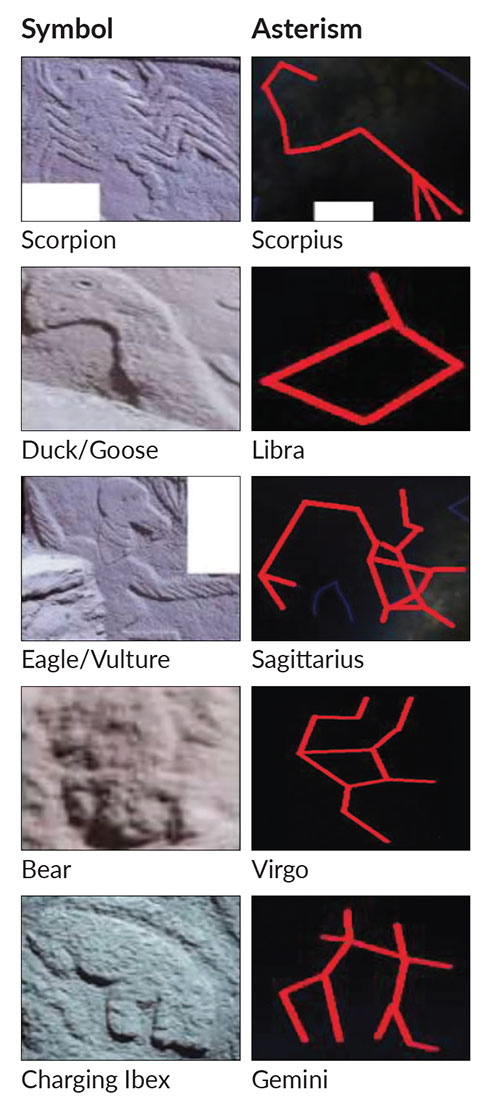
Figure 5. Several examples of supposed correlation between the animals carved on Pillar 43 at Göbekli Tepe compared to the asterisms in the sky 12,800 years ago17
Sweatman’s papers have ended up in two obscure journals called Mediterranean Archaeology and Archaeometry15 and Athens Journal of History.16 I do have to give Sweatman credit for going through peer review, but why those journals? I would suggest their standards for empirical evidence are substantially lower. You be the judge. Figure 5 is taken from Sweatman’s most recent paper.17 He has taken each carving and matched it with a star asterism in the night sky of 12,800 years ago. I suggest that just about any object you can think of could be matched to the asterisms. I don’t see even the least resemblance between carving and asterism. If those asterisms are wrong, then everything else he concludes, particularly the 12,800-year date stamp, is wrong. An interesting test would be to have naïve subjects attempt to match scrambled asterisms to carvings. I predict that there would be very low rater reliability between subjects.
In my last Skeptic article on this subject, I spent a great deal of time lambasting the pseudoscience behind the astrological claims, so I won’t repeat them in detail here. Sweatman and his coauthor18 state: “we verify our scientific hypotheses to an extraordinary level of statistical confidence, far surpassing the usual demands for publication of scientific results. Therefore, in a scientific sense, we prove our hypothesis is correct.” Balderdash! As Mark Twain liked to say, there are “lies, damned lies, and statistics.” And I have yet to find a better place to use the phrase than with this paper. The two authors ask: “What is the probability that the animal symbols on Pillar 43 could appear in their respective places, matching constellations in the night sky so well, if they were chosen and placed at random.” I hope you see the faulty logic here. They assume they have matched the asterisms correctly in a clockwise motion on Pillar 43 to the sky and then ask what the chances are they would be in this order on Pillar 43 randomly.
Well, of course, it is statistically improbable by a whopping amount if the animals were chosen at random on the Pillar 43 but match asterisms. However, that does not mean they were not chosen at random by the carvers. It presumes that the carvers chose them to match the sky. What Sweatman et al. should be trying to access statistically is the likelihood that they have matched the asterisms correctly. I would judge that the matches are fictitious at best (Figure 5). I pointed this out in my critique of their first paper, but Sweatman has ignored my assessment and merely repeats himself in the latest paper, in which he finds that ancient cave art also matches asterisms. I am not the only one to question those claims. Eight of the top researchers at Göbekli Tepe, led by Jens Notroff, wrote a blistering critique of Sweatman’s first paper,19 but the criticism apparently had little impact on his contentions.
It does appear a comet or comets struck about 12,800 years ago based on detailed dating and other evidence found in the layer deposited worldwide from the impact. Sweatman claims on Pillar 43: “the famous ‘Vulture Stone’ [Pillar 43] is a date stamp for 10,950 BC ± 250 yrs [i.e., 12,950 years ago].” How would it be possible for the stone age hunter gathers there to know what the sky looked like in 12,950? The oldest dates for Göbekli Tepe are from 11,600 years ago. It would be impossible for them to document an impact that occurred 1,350 years before the site was built.20 Sweatman responded thusly to the obvious problem in a retort to Notroff et al.: “given the undoubted major impact the YD event would have had on people at the time, we are not at all surprised that an event of this importance is remembered even several millennia later.”21 They remembered for 1,350 years what the sky looked like when a comet struck?
Finally, Hancock contends the carvings are also telling us we are in for another comet strike soon, based on faulty interpretations of the precession (the change in the tilt) of the Earth’s axis. Once again, the prediction is made based on the correlation he claims exists between the carvings and the sky:
However improbable it may seem, therefore, we are obliged to consider the possibility that in 9600 BC [1,350 years after the comet strike] the builders of Göbekli Tepe were already so advanced in their knowledge of the recondite phenomenon of precession that they were able to calculate its effects for thousands of years backward and forward in time in order to produce an accurate symbolic picture…if I understand the message correctly, we’re in the danger zone now.22
Time to build bunkers, I guess.
The Scabland Floods
Randall Carlson appears briefly in the last episode of the Netflix series under the title of amateur geologist and author. He is a smart fellow and a very likable guy. However, he claims to refute the detailed work by professional geologists that demonstrates the cause and extent of the flooding that formed the Scablands found across Montana, Idaho, Washington, and parts of Oregon. The army of scientists that have studied the region note that huge floods over about 8,000 years scarped the Scablands. Geologists have carefully mapped the various deposits. Each individual flood left organic debris enabling radiocarbon dating (Figure 6). I have been involved in detailed stratigraphic mapping in several places in the world, and I can tell you that it is arduous work determining how and when the various deposits were formed. Fine stratigraphic mapping like this is the only way to start to determine the history of the past. Yet as far as I can tell, Carlson has not done any geologic mapping of the region.

Figure 6. The range in dates of the timing of the periodic flooding from Lake Missoula.23
During the last ice age, tongues of the Cordilleran ice sheet periodically dammed the Clark Fork River, creating massive Lake Missoula. During some periods, the lake exceeded depths of 2,000 feet with as much as 600 cubic miles of water behind the dams (Figure 7). Each time the dam ruptured, cataclysmic floods rushed across the western plains, scouring out the Scablands. There were at least 17 of these cataclysmic floods associated with the ice dam rupture. Randall Carlson has no published peer-reviewed papers on these floods, yet based on his conversations with Carlson, Hancock asserts that the conclusion of professional geologists is a “curiously contrived explanation.” Carlson and Hancock attribute the multiple flooding theory to just another form of uniformitarianism — the contention that the Earth’s geology was formed through continuous and uniform processes. What an insult to working geologists!
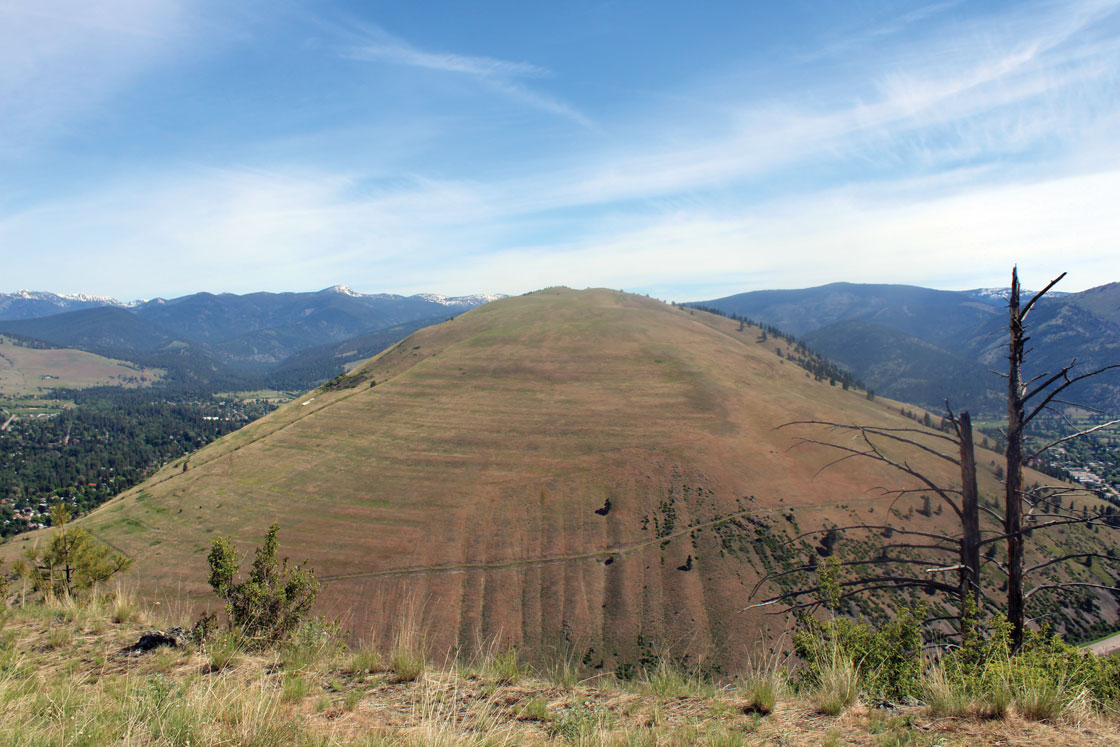
Figure 7. The author is standing at the high-water mark of Lake Missoula at 4200 feet above sea level looking across at wave-cut strandlines representing various levels of the lake above the city of Missoula, MT (2021). We know each of those strandlines represents the level of the lake before a flood occurred. Yet neither Hancock or Carlson address the evidence of multiple huge floods.23 (Photo courtesy of Marc Defant)
Uniformitarianism was popular in the late 19th century, but today all geologists know there have been multiple catastrophes in geologic history. In fact, the multiple massive floods documented in the Scablands are cataclysms of epic proportions. Few, if any, geologists deny a meteorite hit the Earth and annihilated the dinosaurs. And now there is evidence that a comet struck Earth 12,800 years ago. Hancock is trying to undermine the results of geologists that have been working for decades in the area by pretending they claim there were no cataclysms. There was nothing gradual about the floods geologists have documented.

This article appeared in Skeptic magazine 28.1
Buy print edition
Buy digital edition
Subscribe to print edition
Subscribe to digital edition
Download our app
As well, Carlson insists that there was only one huge flood that lasted only weeks, and that it came from the north instead of the west where Lake Missoula was (Figure 8, next page). He then opines that if you took the water from “every single river on earth on every continent, add that together, you still would have to times that by ten to get the volume of water flowing through here.” And where did that water come from? A comet that struck the Cordilleran Ice Sheet. The comet struck about 12,800 years ago, but the dating of the floods shows that the flooding occurred primarily over 7,000 years prior to the comet strike (Figure 6). Carlson, flummoxed by the dates and his scientific predicament, concludes that we need to take another hard look at the dates as if geologists have not already done so multiple times. There has never been any evidence found to suggest a comet or multiple comets struck in Canada 12,800 years ago, with or without the glacier there.
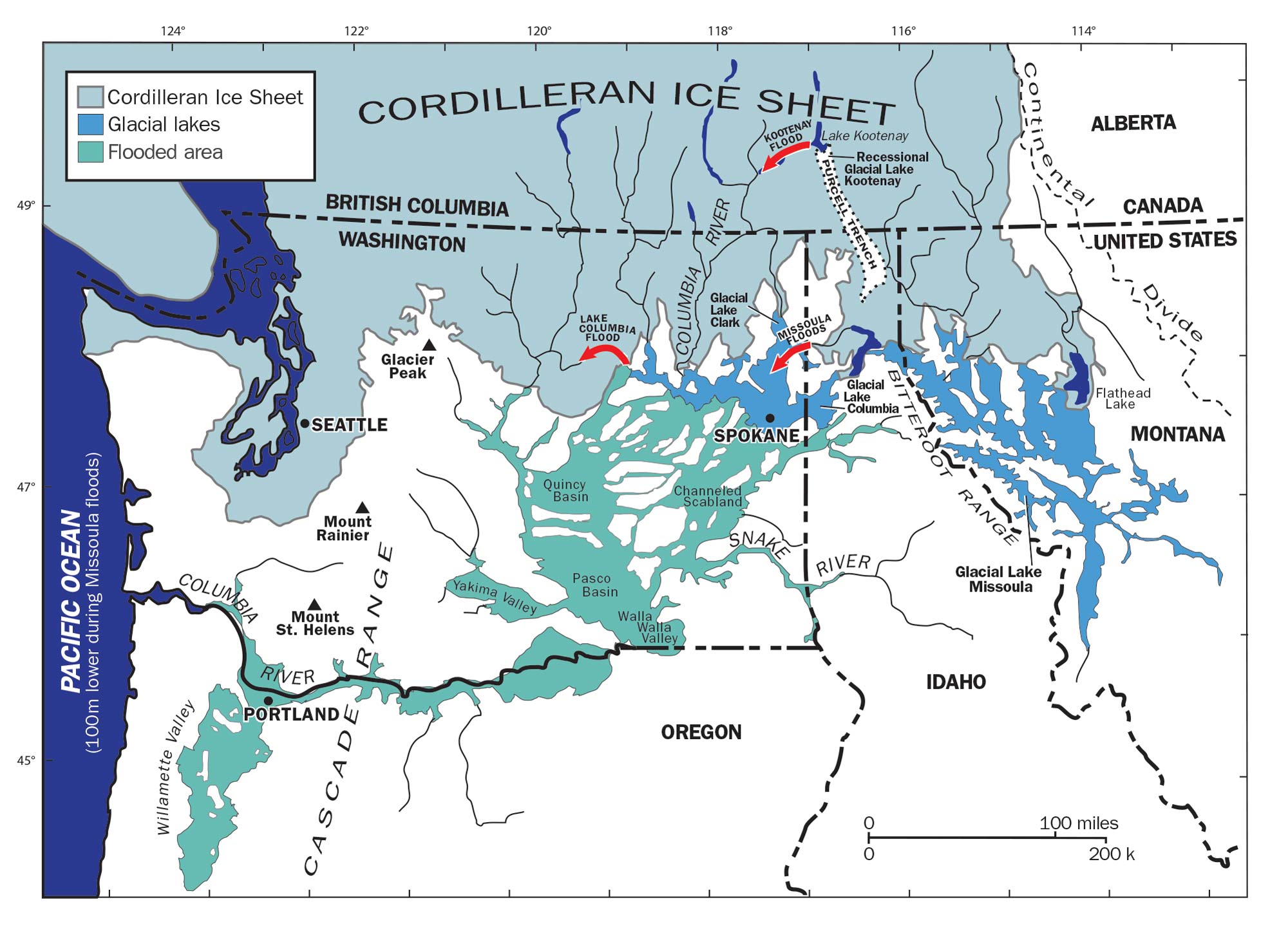
Figure 8. The distribution of Lake Missoula and the flooded areas23
Conclusion
In 1890 noted geologist T.C. Chamberlin proposed “the method of a multiple working hypothesis,” which advocated for developing several hypotheses, testing them, and then rejecting all that do not fit the data. In my assessment, Graham Hancock’s alternative theory of history has no data to support it and is based almost entirely on “anomaly hunting” through archaeological sites, selective presentation of such anomalies as being commonplace, rather than rare, which is what they are, ignoring the massive evidence in favor of the mainstream theory of history, misreading myths like Atlantis to be accurate descriptions of real, historical events, and grand storytelling that obscures the complexities of history. If the Netflix special demonstrates anything, it is that skeptics have a lot of work to do. ![]()
About the Author
Marc J. Defant is a professor of geology at the University of South Florida specializing in the study of volcanoes — more specifically, the geochemistry of volcanic rocks. He has been funded by the NSF, National Geographic, the American Chemical Society, and the National Academy of Sciences and has published in many international journals including Nature. His book Voyage of Discovery: From the Big Bang to the Ice Age is in the 2nd edition.
References
- https://bit.ly/3FPW278
- Feder, K. L. (2019). Frauds, Myths, and Mysteries: Science and Pseudoscience in Archaeology 10th Edition. Oxford University Press.
- https://bit.ly/3HYdM2X
- Van Tilburg, J. A. (1994). Easter Island: Archaeology, Ecology and Culture. British Museum.
- Diamond, J. (2011). Collapse: How Societies Choose to Fail or Succeed. Penguin Publishing Group.
- Hunt, T. and Lipo, C. (2012). The Statues That Walked. Counterpoint Press.
- von Däniken, E. (1971). Gods From Outer Space. Bantum Books.
- https://bit.ly/3YFn4qx
- Clare, L., Notroff, J. and Sonmez, D. (2018). History Making at Göbekli Tepe. In I. Hodder (Ed.), Religion, History, and Place in the Origin of Settled Life. University of Colorado Press.
- https://bit.ly/3FPW278
- Hancock, G. (2015). Magicians of the Gods: The Forgotten Wisdom of Earth’s Lost Civilization. Saint Martin’s Press.
- Early Pottery at 20,000 Years Ago in Xianrendong Cave, China. Wu, Xiaohong, et al. 2012, Science, Vol. 336, pp. 1692–1700.
- Clare, L., Notroff, J. and Sonmez, D. (2018). History Making at Göbekli Tepe. In I. Hodder (Ed.), Religion, History, and Place in the Origin of Settled Life. Univsrsity of Colorado Press.
- Hancock, G. (2015). Magicians of the Gods: The Forgotten Wisdom of Earth’s Lost Civilization. Saint Martin’s Press.
- https://bit.ly/3Ig0Llx
- https://bit.ly/3hO9vUY
- Ibid.
- Ibid.
- https://bit.ly/3VkmhYY
- Ibid.
- Ibid.
- Hancock, G. (2015). Magicians of the Gods: The Forgotten Wisdom of Earth’s Lost Civilization. Saint Martin’s Press.
- Megafloods and Clovis Cache at Wenatchee. Waitt, R.B. 2016, Quaternary Res., Vol. 85, pp. 430–444.
This article was published on June 9, 2023.







